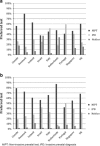Preferences for prenatal tests for Down syndrome: an international comparison of the views of pregnant women and health professionals
- PMID: 26577044
- PMCID: PMC5070900
- DOI: 10.1038/ejhg.2015.249
Preferences for prenatal tests for Down syndrome: an international comparison of the views of pregnant women and health professionals
Abstract
Non-invasive prenatal testing is increasingly available worldwide and stakeholder viewpoints are essential to guide implementation. Here we compare the preferences of women and health professionals from nine different countries towards attributes of non-invasive and invasive prenatal tests for Down syndrome. A discrete choice experiment was used to obtain participants' stated preference for prenatal tests that varied according to four attributes: accuracy, time of test, risk of miscarriage, and type of information. Pregnant women and health professionals were recruited from Canada, Denmark, Iceland, Israel, Italy, the Netherlands, Portugal, Singapore, and the United Kingdom. A total of 2666 women's and 1245 health professionals' questionnaires were included in the analysis. Differences in preferences were seen between women and health professionals within and between countries. Overall, women placed greater emphasis on test safety and comprehensive information than health professionals, who emphasised accuracy and early testing. Differences between women's and health professionals' preferences are marked between countries. Varied approaches to implementation and service delivery are therefore needed and individual countries should develop guidelines appropriate for their own social and screening contexts.
Figures



Similar articles
-
Women's and health professionals' preferences for prenatal tests for Down syndrome: a discrete choice experiment to contrast noninvasive prenatal diagnosis with current invasive tests.Genet Med. 2012 Nov;14(11):905-13. doi: 10.1038/gim.2012.68. Epub 2012 Aug 30. Genet Med. 2012. PMID: 22935718
-
[Women´s preferences for prenatal tests A discrete choice experiment to contrast noninvasive prenatal testing with current invasive tests].Laeknabladid. 2016 Jun;102(6):277-82. doi: 10.17992/lbl.2016.06.85. Laeknabladid. 2016. PMID: 27295145 Icelandic.
-
Evaluation of preferences of women and healthcare professionals in Singapore for implementation of noninvasive prenatal testing for Down syndrome.Singapore Med J. 2017 Jun;58(6):298-310. doi: 10.11622/smedj.2016114. Epub 2016 Jun 29. Singapore Med J. 2017. PMID: 27357315 Free PMC article.
-
Exploring measurement tools used to assess knowledge, attitudes, and perceptions of pregnant women toward prenatal screening: A systematic review.Womens Health (Lond). 2024 Jan-Dec;20:17455057241273557. doi: 10.1177/17455057241273557. Womens Health (Lond). 2024. PMID: 39206551 Free PMC article.
-
Provision and uptake of routine antenatal services: a qualitative evidence synthesis.Cochrane Database Syst Rev. 2019 Jun 12;6(6):CD012392. doi: 10.1002/14651858.CD012392.pub2. Cochrane Database Syst Rev. 2019. PMID: 31194903 Free PMC article.
Cited by
-
Dealing with uncertain results from chromosomal microarray and exome sequencing in the prenatal setting: An international cross-sectional study with healthcare professionals.Prenat Diagn. 2021 May;41(6):720-732. doi: 10.1002/pd.5932. Epub 2021 Mar 30. Prenat Diagn. 2021. PMID: 33724493 Free PMC article.
-
Awareness of down syndrome screening among educated Muslim women is associated with a favorable attitude toward testing.BMC Womens Health. 2024 Sep 12;24(1):508. doi: 10.1186/s12905-024-03346-y. BMC Womens Health. 2024. PMID: 39267004 Free PMC article.
-
Preconception education program for non-invasive prenatal testing focused on interest in genetics among female university students in Japan: a quasi-experimental study comparing pre-intervention, post-intervention, and three-month follow-up results.Arch Public Health. 2023 Jul 27;81(1):138. doi: 10.1186/s13690-023-01157-5. Arch Public Health. 2023. PMID: 37501058 Free PMC article.
-
Uptake, outcomes, and costs of implementing non-invasive prenatal testing for Down's syndrome into NHS maternity care: prospective cohort study in eight diverse maternity units.BMJ. 2016 Jul 4;354:i3426. doi: 10.1136/bmj.i3426. BMJ. 2016. PMID: 27378786 Free PMC article.
-
The effectiveness of non-invasive prenatal test technology and the prenatal screening algorithm based on various methods for determining foetal aneuploidy.J Turk Ger Gynecol Assoc. 2023 Sep 7;24(3):152-158. doi: 10.4274/jtgga.galenos.2023.2022-10-4. J Turk Ger Gynecol Assoc. 2023. PMID: 37675072 Free PMC article.
References
-
- Gil MM, Quezada MS, Revello R, Akolekar R, Nicolaides KH: Analysis of cell-free DNA in maternal blood in screening for fetal aneuploidies: updated meta-analysis. Ultrasound Obstet Gynecol 2015; 45: 249–266. - PubMed
-
- American College of Obstetricians and Gynecologists: Committee opinion no. 640: cell-free dna screening for fetal aneuploidy. Obstet Gynecol 2015; 126: e31–e37. - PubMed
-
- Norton ME, Jacobsson B, Swamy GK et al: Cell-free DNA analysis for noninvasive examination of trisomy. N Engl J Med 2015; 372: 1589–1597. - PubMed
-
- Warsof SL, Larion S, Abuhamad AZ: Overview of the impact of noninvasive prenatal testing on diagnostic procedures. Prenat Diagn 2015; 35: 972–979. - PubMed
Publication types
MeSH terms
Grants and funding
LinkOut - more resources
Full Text Sources
Other Literature Sources
Medical

